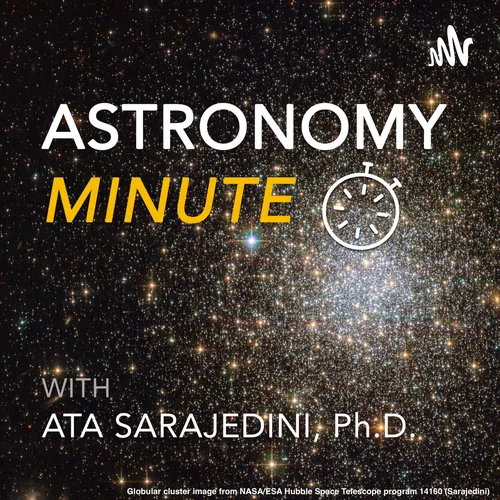
Astronomy Minute
Learn the basics of astronomy in one-to-two minute packets of concise information about specific topics. You are a busy person with a short attention span, and you want to learn about astronomical topics in a short amount of time. Your host Professor Ata is a PhD research astronomer and astrophysicist and a noted authority on stellar and galactic astronomy. I welcome your feedback at [email protected]. See the web site astronomyminute.org for more. The podcast logo is courtesy of Zachary Greathouse and shows a globular cluster photo taken by the author with the Hubble Space Telescope.
- Update frequency
- every 3 days
- Average duration
- 1 minutes
- Episodes
- 183
- Years Active
- 2020 - 2023

What is the Doppler Effect and Redshift?
A brief description of the Doppler Effect and how it can be used to measure the motion of celestial objects toward (via blueshift) and away (via redshift) from us.

What is the Inverse Square Law of Light?
A brief description of the inverse square law of light and how we use it to determine the distances of celestial objects.

What are Newton's Laws of Motion?
A brief description of Isaac Newton's three laws of motion.

Can the Millennium Falcon Really do the Kessel run in 12 parsecs?
A basic definition of the distance unit we call a Parsec.

Does Science Prove Things?
A brief description of how science does not prove things but rather provides evidence in favor of or against a particular theory.

How do we know there is a black hole at the center of our galaxy?
A description of the main piece of evidence supporting the hypothesis that there is a black hole at the center of our galaxy.

What are Kepler's Laws?
A brief description of Kepler's Three Laws of Planetary Motion.

What are Active Galaxies?
A basic description of an active galaxy and how it produces the energy that we observe from it.

How Did the Solar System Form?
A brief description of the Nebular Hypothesis which is believed to describe how the Solar System formed.

Why Did I Create These Podcasts?
A brief explanation of why I felt the need to create another podcast about astronomy.

Will Polaris Always be the North Star?
A description of Precession of the Equinoxes which determines what the north star will be.

What Happened to Pluto Formerly Known as a Planet?
A description of one of the main reasons why Pluto is no longer classified as a planet.

How Do We Name Stars?
A brief description of how astronomers refer to individual stars in the sky.

What is a Constellation?
A brief description of what the ancients and modern astronomers call constellations.

What are Variable Stars?
A brief description of the two very broad categories into which variable stars are classified.

What is Helioseismology?
A description of what helioseismology is and how we can use it to determine the various properties of the Sun.

What do Astronomers do?
A brief explanation of what professional astronomers actually do in their role of applying the scientific method to better understanding the Universe.

What is the Difference Between Astronomy and Astrophysics?
What is the Difference Between Astronomy and Astrophysics? In a word, nothing!

How do we use Light to Study the Universe?
A brief description of the ways in which we analyze light to help us better understand the Universe.

What is the Solar System?
A description of the basic constituents of the Solar System.